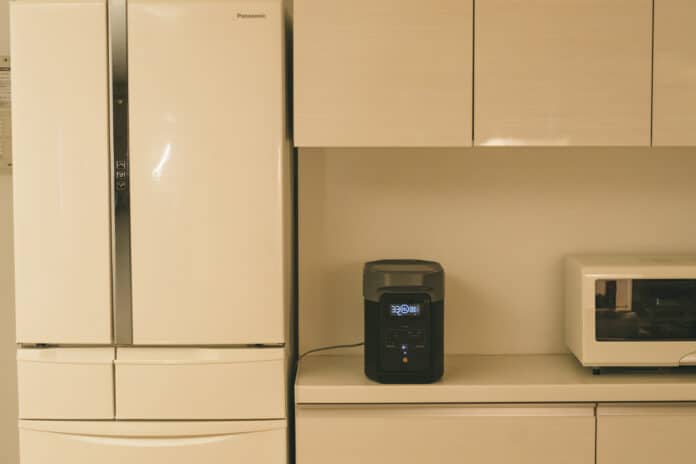While they’ve been around for less than a hundred years, microwaves have become a staple in practically every American kitchen. Who wants to wait for an oven to heat up to perform a simple task like reheating leftovers?
These magically versatile little devices have become so integral to our daily lives that it’s easy to lose track of how much energy they use. Determining how many watts your microwave uses is crucial, though, if you’re going to use it in an unconventional environment, like on an RV or boat.
You must also know the starting and operating wattage of any appliances you want to use with a generator or backup battery system during a blackout.
Here is a complete guide to microwave wattage.

How Much Electricity Does a Microwave Use?
More than 90% of American households own a microwave. But despite their prevalence in nearly every home, microwave electricity consumption can vary drastically.
Nowadays, most popular compact models range from 500 to 800 watts, with medium to large models using 800 to 1800 watts. Commercial microwave ovens have a minimum requirement of 1200 watts and only go up from there.
The variation in wattage usually comes down to heating capacity, size, and type — whether countertop, over-the-range, or built-in.
Microwaves with more heating capacity typically require more energy, with more watts equalling more power. Your basic countertop model may use 700 watts or less, but it’ll be slower and less efficient than an Energy Star comparable higher-wattage model.
If you’re going to defrost meats like beef and pork regularly, or if you’re in the culinary or catering businesses and rely on your microwave, it’s best to go with a high-wattage workhorse.
How much of a drain microwaves are on your electricity bill has changed dramatically since the Raytheon engineer Percy Spencer first invented the microwave in 1945. As manufacturers continue to develop more advanced technologies, we can expect that even more energy-efficient microwaves will be widely available.

How To Find the Wattage of the Microwave
You can find the wattage range on your microwave right on the appliance, usually labeled on the door or inside. You can also find the information in the owner’s manual or manufacturer’s website.
One thing to note is that the microwave wattage rating often indicates its “cooking power” or how much electricity it needs to run after you turn it on. The surge power required to start a microwave may be multiple times higher than the cooking power and should be listed as a separate spec on the appliance.
If you’re just purchasing a new microwave and plugging it into a wall outlet, the surge power probably doesn’t matter. But if you plan to power your microwave using a generator, you’ll want to be sure your system’s maximum AC output can handle the microwave’s surge power demand.

How Much Does it Cost To Power a Microwave?
Microwaves aren’t typically expensive to run since most people only use them to heat food for a few minutes. However, every time you use it, it does add to your electric bill.
To calculate how much it costs to power your microwave, you can use the simple 3-step formula below.
Simply plug in the wattage of your appliance, daily run time, and your state’s per kWh electricity rate to determine your microwave’s daily operating cost:
First, calculate how many watt hours (wH) your microwave consumes per day.
- Wattage (W or kW) x Running time (h) = wH
For example, a 700W microwave operating for 15 minutes daily (.25h) consumes about 175 Wh a day.
Electricity prices from utility companies are given in kWh, so you must convert your average daily wH to kWh by dividing the wH by 1,000. One kilowatt-hour (kWh) is equal to 1,000 Wh.
- wH / 1000 = kWh
As in the example above, a 700W microwave running for 15 mins a day consumes about 0.175 kWh daily.
3. kWh usage x kWh electricity price = average daily energy cost
If your per/kWh electricity rate is $0.20, the daily cost to operate your 700W microwave for 15 mins is $0.035, and the average monthly cost is $1.05.
You can look up your state’s electricity rates per kilowatt-hour or consult a recent electricity bill to determine how much each kWh of electricity you consume costs.
It’s crucial to understand the math behind determining your essential appliances’ energy usage and cost if you’re considering purchasing a whole home generator or backup battery solution.
If you’re not in the mood to dust off your calculator, Energy.gov has an online tool that can give you a rough estimate of energy costs per appliance/by state in under a minute.

FAQs
A solar generator can power a microwave or any other appliance if the generator’s storage and power output capacity is sufficient for your consumption needs. The EcoFlow DELTA 2 + 220W Portable Solar Panel is an excellent entry-level home backup solution that you can use to power a microwave, fridge, LED lights, and more.
After your initial investment in a solar generator, it costs nothing to convert sunlight into electricity. Use the equations above to determine how much it costs to power your microwave and other appliances. Then it’s easy to estimate how much you can save on your electricity bills by switching to solar.

Conclusion
If you’re looking to save on utility bills — and have an off-grid power supply at the ready — switching appliances like microwaves over to solar is a great place to start.
If your sole reason for switching to solar is to save on electricity bills, keep in mind it will likely take several years to pay off your initial investment. The time between purchasing a solar power system and recouping your costs is often called the solar payback period.
What’s harder to put a price tag on is energy independence and knowing your family can access electricity, regardless of aging grid infrastructure and rising fuel costs.Check out EcoFlow for a wide range of solar generators. With the right portable power station and solar panel array, you can build a customized all-in-one home backup or off-grid power solution.
